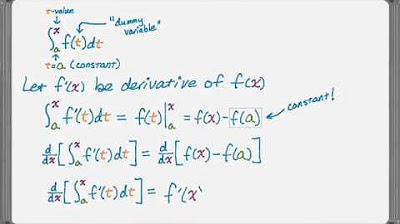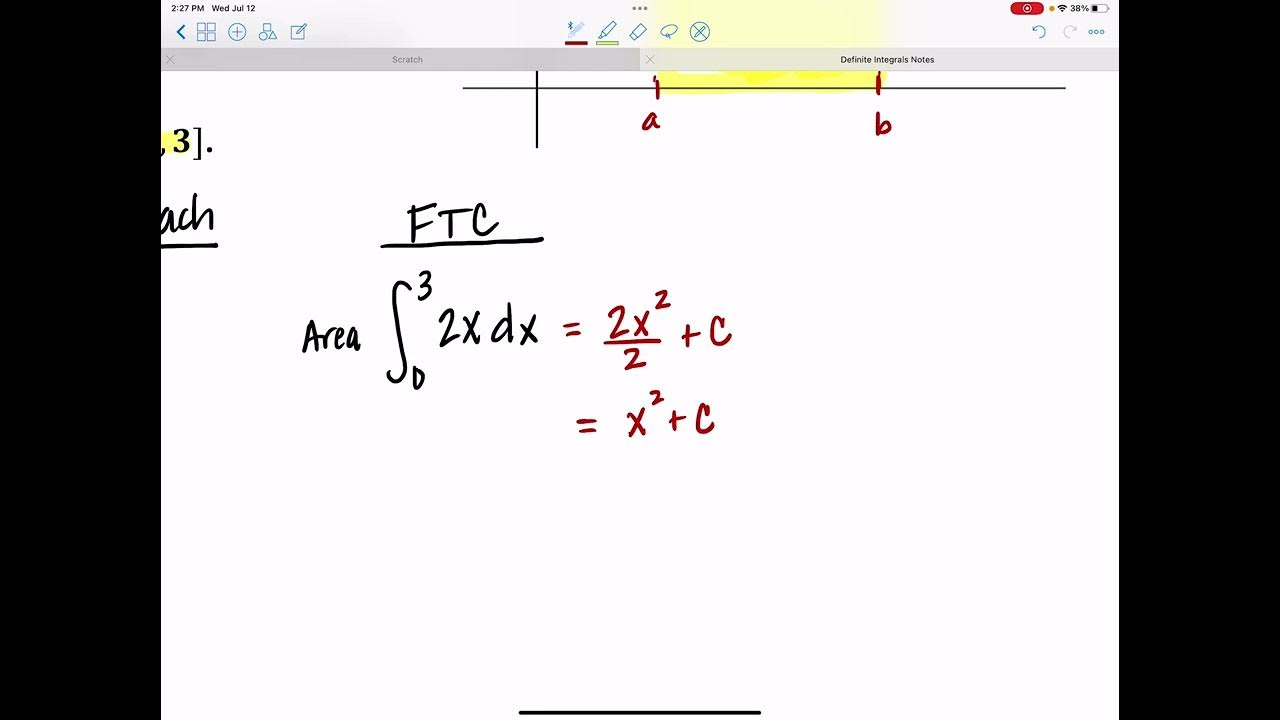The Second Fundamental Theorem of Calculus
TLDRThis video lesson introduces the Second Fundamental Theorem of Calculus, which states that the derivative of the integral of a continuous function from a constant 'a' to a variable 'x' is the function itself evaluated at 'x'. The instructor explains the concept using an accumulation function to represent the area under the curve and demonstrates the theorem through examples, both with and without shortcuts. The lesson also touches on the necessity of the chain rule when the upper limit of integration is not 'x', and encourages viewers to watch additional videos for more complex scenarios.
Takeaways
- 📚 The lesson introduces the Second Fundamental Theorem of Calculus, also known as Part One in some textbooks.
- 🔍 The theorem applies to continuous functions 'f' on an open interval containing a constant 'a'.
- 📉 The derivative of the integral of 'f(t)' from 'a' to 'x' with respect to 'x' is equal to 'f(x)', where 'a' is a constant and 'x' is the variable upper limit of integration.
- 📈 The integral with a variable upper limit represents the accumulation function 'a(x)', which gives the area of the shaded region between 'a' and 'x'.
- 🧩 The derivative of the accumulation function 'a(x)' is simply 'f(x)', the integrated function evaluated at 'x'.
- ⚠️ If the upper limit of integration is not 'x', such as '2x' or 'x^2', the derivative is not straightforward and requires the chain rule.
- 🔑 To justify the theorem, one can find the difference quotient and then take the derivative with respect to 'x'.
- 🔍 The anti-derivative 'F(t)' is used to evaluate the difference quotient, leading to 'F'(x) - 'F'(a), where 'F' is the anti-derivative of 'f'.
- 📝 The derivative of 'F(x) - F(a)' simplifies to 'f(x)', confirming the theorem's result without needing to find anti-derivatives.
- 📚 The script provides examples to illustrate the theorem's application, including a simple integral where the anti-derivative is 't^2'.
- 🔍 The examples demonstrate taking the derivative of integrals using the theorem, such as 'sin^3(x) / (x^(5/3) + 1)' and '15x^(5/3) / (ln(x)^3 + x^2)'.
- 🔗 The Second Fundamental Theorem of Calculus highlights the relationship between differentiation and integration and simplifies finding derivatives of integrals.
Q & A
What is the second fundamental theorem of calculus?
-The second fundamental theorem of calculus states that if a function 'f' is continuous on an open interval 'I' containing a constant 'a', then the derivative with respect to 'x' of the integral of 'f(t)' from 'a' to 'x' equals 'f(x)'.
What does the integral with a variable upper limit represent in the context of the second fundamental theorem?
-In the context of the second fundamental theorem, the integral with a variable upper limit represents the accumulation function, which gives the area of the shaded region between the constant 'a' and the variable 'x'.
How can we find the derivative of an integral with a constant lower limit and a variable upper limit without using the second fundamental theorem?
-To find the derivative of such an integral without using the theorem, you would first find the anti-derivative function 'F(t)', then evaluate the difference 'F(x) - F(a)', and finally take the derivative of this result with respect to 'x'.
What happens if the upper limit of integration is not 'x' but another function of 'x'?
-If the upper limit of integration is not 'x' but another function of 'x', such as '2x' or 'x^2', finding the derivative of the integral would require the application of the chain rule.
What is the role of the anti-derivative in justifying the outcome of the second fundamental theorem?
-The anti-derivative plays a crucial role in the justification process. By finding the anti-derivative 'F(t)' and evaluating its derivative at 'x' and 'a', and then taking the difference, we can show that the derivative of the integral equals the original function 'f(x)'.
Can you provide an example of how to apply the second fundamental theorem to find the derivative of an integral?
-Sure, if you have an integral of 'f(t)' from '2' to 'x', to find the derivative, you simply substitute 'x' for 't' in 'f(t)', which gives you 'f(x)', the derivative of the integral.
What is the significance of the second fundamental theorem of calculus in the relationship between differentiation and integration?
-The second fundamental theorem of calculus highlights the inverse relationship between differentiation and integration. It allows us to find the derivative of an integral without the need to find the anti-derivative first.
How does the second fundamental theorem simplify the process of finding derivatives of certain integrals?
-The second fundamental theorem simplifies the process by allowing us to directly substitute the variable 'x' into the integrated function to find the derivative of the integral, bypassing the need to calculate the anti-derivative.
What is the 'diff integral' mentioned in the script, and how does it relate to the second fundamental theorem?
-The 'diff integral' refers to the process of finding the difference between the anti-derivatives evaluated at two points. It is used to justify the second fundamental theorem by showing that the derivative of the integral equals the original function.
Can the second fundamental theorem be applied to integrals with non-constant lower limits?
-The second fundamental theorem, as stated, applies to integrals with a constant lower limit. If the lower limit is not constant, additional steps such as the chain rule may be necessary to find the derivative of the integral.
Outlines
📚 Introduction to the Second Fundamental Theorem of Calculus
This paragraph introduces the second fundamental theorem of calculus, which is sometimes referred to as part one in some textbooks. It explains that for a continuous function 'f' on an interval containing a constant 'a', the derivative of the integral of 'f(t)' from 'a' to 'x' with respect to 'x' is equal to 'f(x)'. The concept of the integral as an accumulation function is introduced, where the derivative of this function is simply the integrated function evaluated at 'x'. The paragraph also mentions that if the upper limit of integration is not 'x', the process is more complex and may require the chain rule, with examples provided in other videos. The justification for this outcome is suggested through finding the difference quotient and then the derivative, leading to the conclusion that the derivative of the anti-derivative function equals the original function 'f(x)'.
🔍 Applying the Second Fundamental Theorem of Calculus with Examples
The second paragraph focuses on applying the second fundamental theorem of calculus to find the derivative of integrals without needing to find anti-derivatives. It emphasizes the theorem's utility in simplifying the process of differentiation. The paragraph provides two examples to illustrate the application of the theorem. The first example involves the derivative of an integral with a lower limit of 2 and an upper limit of 'x', where the derivative is found by substituting 'x' into the integrated function. The second example is similar, with an integral from 5 to 'x', and the derivative is again found by substitution. The paragraph concludes by highlighting the theorem's demonstration of the relationship between differentiation and integration and mentions additional videos that cover the application of the chain rule in conjunction with the second fundamental theorem.
Mindmap
Keywords
💡Second Fundamental Theorem of Calculus
💡Continuous Function
💡Integral
💡Derivative
💡Anti-derivative
💡Chain Rule
💡Accumulation Function
💡Variable Upper Limit
💡Constant Lower Limit
💡Differentiation Under the Integral Sign
Highlights
Introduction to the second fundamental theorem of calculus.
The theorem is also known as part one of the fundamental theorem of calculus in some textbooks.
The theorem states the relationship between the derivative of an integral and the integrated function.
Explanation of the integral with a variable upper limit as an accumulation function.
Derivative of the accumulation function is the integrated function evaluated at x.
Clarification on the complexity when the upper limit of integration is not x.
Application of the chain rule for non-x upper limits in integrals.
Justification of the theorem's outcome by finding the difference quotient and then the derivative.
Process of finding the anti-derivative and evaluating the difference quotient.
Derivative of a constant is zero, simplifying the difference quotient.
Demonstration of the theorem using a simple integral.
Long way calculation versus the shortcut provided by the theorem.
Example of finding the derivative of an integral with the anti-derivative method.
Shortcut application in finding the derivative of an integral.
Example of applying the theorem to an integral with a trigonometric function.
Example of applying the theorem to an integral with a logarithmic function.
The theorem's significance in the relationship between differentiation and integration.
Mention of additional resources for further understanding.
Transcripts
Browse More Related Video

1st Fundamental Theorem of Calculus PROOF | Calculus 1 | jensenmath.ca

Calculus (Version #2) - 9.1 The Second Fundamental Theorem of Calculus

Second Fundamental Theorem of Calculus 2nd FTC

Definite Integrals

Calculus AB/BC – 6.4 The Fundamental Theorem of Calculus and Accumulation Functions

Definite Integrals!
5.0 / 5 (0 votes)
Thanks for rating: